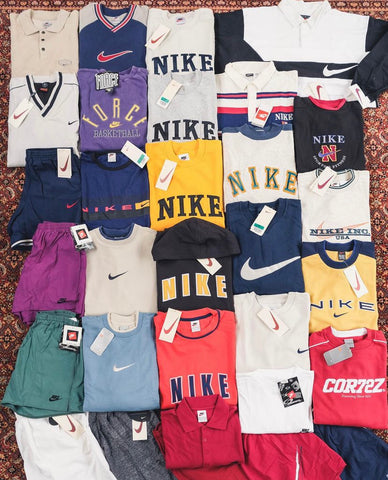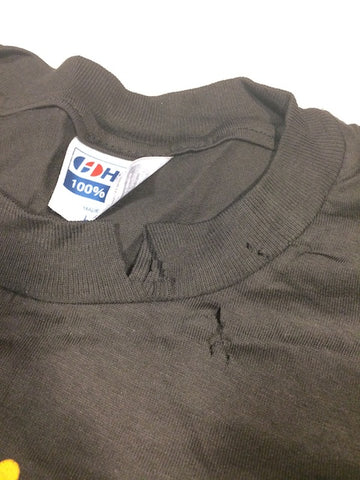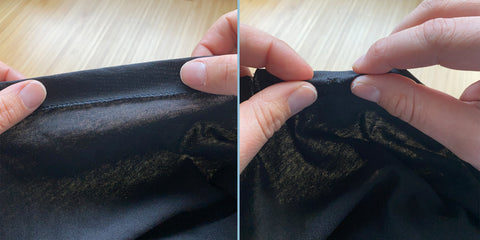
All Things Vintage: Deadstock & Dryrot
The third installment of "All Things Vintage" is all about unsalvaged deadstock treasures, where to find them, and the fear of dryrot (and how to protect yourself from it)!

What is Deadstock?
"Deadstock" refers to old stock or remnants that lie around unused or unsold - often in old storerooms, dusty shops or even in the farthest corner of a cellar. In this context, the term "NOS" ("new old stock") is often used.
Deadstock is vintage royalty: after all, the pieces are in brand new condition, even though they've been lying around for 20 or 30 or sometimes a hundred years. You found a pair of Levi's jeans from the 1950s, preferably with the label still on them? Or you found an original shrink-wrapped Nirvana shirt from 1992 at a flea market? Jackpot!
Where to find deadstock (and what's the risk)?
Remnants of clothing often lie dormant where they should actually once be sold: In old sports stores, for example. The fact that there might still be (for example) fresh training jackets from the 90s often has to do with changing trends: stores get new pieces in new colors and with new cuts every season. And so a jacket in turquoise and purple had had its day by the mid-90s at the latest. If it didn't go on sale, it probably went to the back shelf of the store. Then into a box in the warehouse. And if there was no more room, maybe in the basement or in the attic of the store owners.

The first rule of finding deadstock is to keep your eyes open. Does a store look like it might have been around for a while? Then there could be treasures waiting for you. If you haven't found anything old in the store, the second rule is to ask! Ask if the store has any older merchandise that is not on display. Most likely, the question will surprise your counterpart at first, because in clothing stores what generally applies is: "Old = worthless".
At flea markets the same applies: The seller offers a perfectly preserved (but obviously old) piece? Better ask where it comes from and if there are more of them. We have already found some rarities this way!
But be careful: Especially because old stock is often still in its original packaging or has never been worn, you should know a few "dangers". With old pieces with artificial leather, the material can become crumbly. With old sneakers with foam soles - for example, some Jordans - the sole becomes porous and gets crushed into a thousand pieces with one step. If a piece was in the store window for a long time, it is highly likely that the top of the item will be completely faded (and the rest of the piece will look brand new, which is really weird). For pieces made of animal fabrics, moths might have quietly taken up residence. And with t-shirts? There is one big fear going around in the scene: Dryrot! More about this in the next but one point!
What is Dryrot?
There is no proper translation for "Dryrot" in German (which already shows how little people outside the vintage community know about it): You could translate dryrot as "Trockenfäule" but that's more commonly spoken of in plants when they become hardened or rotten.
"Rotten" isn't a bad keyword, though: t-shirts that are dryrot can be torn without a problem. And not like when wrestlers theatrically rip their shirts in the ring. When a shirt is "dryrot", you can pull on it with two fingers and RATCH it has a hole (and is unwearable).
How does something like this happen? Dryrot is the result of a chemical reaction - which, by the way, only occurs in black t-shirts! Until the early 2000s (and sometimes after), black shirts were often dyed with sulfur-based dye. The problem with this is that if such a shirt has never been washed, the sulfur content becomes insoluble and "acidifies" over time. The sulfur thus attacks the cotton and makes the shirt so porous that you can tear it like a piece of paper.
What to do against Dryrot?
The bad news first: There is absolutely nothing you can do against Dryrot. "Soak in milk," etc. - that's all myths from the Internet and definitely doesn't work. But now for the good news: you can test a shirt for Dryrot with a simple trick before you even buy it.
The tear test
Turn the shirt inside out. On the inside of the shirt, hold a piece of fabric from the hem with your thumb and forefinger - as if you were tugging it. Secure another piece of fabric two inches away with the thumb and forefinger of your other hand. Now pull firmly in both places in opposite directions.

If the fabric tears at this point, the case is clear: we are dealing with Dryrot. If not, always play it safe: do the test now on both sleeve ends and, as a precaution, on other parts of the shirt as well. Why? The sleeves could be made from a different piece of fabric than the body of the shirt - just because a part of the shirt is not dryrot does not mean the sleeves are not. To be absolutely sure, repeat the whole process again when the shirt has been in the washing machine (and then, of course, has already been purchased).
A brief explanation: by tugging at the hem of the inside, the shirt is not immediately destroyed in the case of Dryrot. After all, you could still frame it - better than nothing. And especially if you ask private sellers (online) to do this test, they can't hold it against you that the shirt is now completely broken.
By the way, there are also other signs for Dryrot: This can be an acrid sour smell. A strong shining of the black surface. In addition, black color on the fingers, if you stroke over the shirt. Or accompanying black little crumbs that come off the shirt when you shake it. However, this can also occur for other reasons - only the tear test above can provide 100% certainty.
And now we keep our fingers crossed that you find lots of deadstock (and that it's not dryrot)! By the way, we also buy: So if you don't know where to put your finds, just write us or come to our store in Mannheim. If the pieces are interesting for us, we are happy to take five or 100 pieces at once :)
PS: In our current Deadstock Drop you won't find any Dryrot (because we check every piece carefully), but rare band shirts and more from the 90s to the early 2000s!